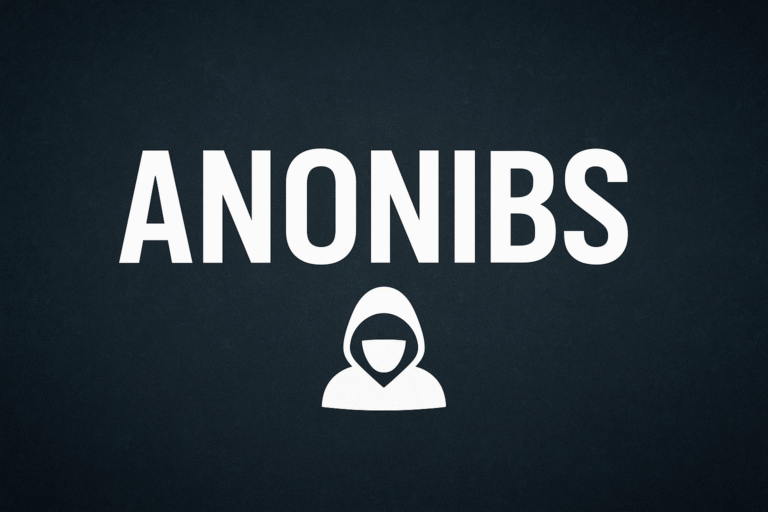
Introduction
Welcome to the world of Anonibs—an intriguing, somewhat controversial, yet fascinating platform for anonymous sharing. In today’s digital era where identity, reputation and personal data often dominate our online presence, Anonibs offers a refreshing or unsettling alternative (depending on your viewpoint). Whether you’re a creator seeking freedom, a reader looking for raw voices, or a curious observer of digital culture, understanding the rise and role of Anonibs is both timely and relevant.
In this article, we’ll dive deep into what Anonibs is, how it works, why it matters, its benefits and drawbacks, comparisons with other platforms, and practical tips for safe use. Let’s get started.
What Is Anonibs?
Let’s begin with the core: what exactly is Anonibs? At its simplest, Anonibs is a platform or concept built around anonymous communication—sharing ideas, images, opinions, without the usual identity baggage
Here’s the breakdown:
- “Anon” stands for anonymity, and “ibs” suggests boards, spaces or platforms for interaction
- Users can post without revealing their real names, avoiding the normal social weight of “who am I” or “what do others think of me.
- The content often revolves around sharing views, creative works, images, beliefs, or simply venting—all under the canopy of privacy.
Why does this matter? Because in a world saturated with curated personas, Anonibs flips the script: you participate where what you say matters more than who you are.

Why Anonibs Is Gaining Traction
Why are people turning to anonymous sharing via Anonibs? There are several compelling drivers behind its growth:
1. Privacy concerns and identity fatigue
Many users are tired of linking every post or comment to their identity. With growing data breaches, surveilled platforms and reputation-economies, anonymity becomes appealing. Anonibs taps into that desire.
2. Freedom of expression
When you’re not tied to a profile, you feel freer to voice unpopular opinions, ask sensitive questions, or share personal stories without fear of judgment. That sense of liberation fuels Anonibs.
3. Creative and support-oriented spaces
Writers, artists and seekers of peer support (especially around mental health or taboo topics) may find safe refuge in anonymous spaces. Anonibs allows that.
4. Shift in digital culture
As more platforms are forced to moderate heavily or tie posts to identities, the counter-movement is anonymity. That shift fuels interest in things like Anonibs.
In essence, the rise of Anonibs reflects a broader struggle: balancing identity-driven social media and raw, unfiltered sharing.

How Anonibs Works (Behind the Scenes)
Getting better acquainted with Anonibs means understanding the mechanics: how the platform functions, what features it offers, and how users interact.
- Minimal registration: Often, you don’t need full profile data—sometimes just an alias or no login at all. This lowers barriers to entry.
- Topic-focused boards or threads: Similar to imageboards or forums, Anonibs may have categories for sharing experiences, art, venting, Q&A, etc.
- Image and media sharing: Many entries involve visuals (images, memes, drawings), amplifying the impact of anonymity.
- Moderation / Lack thereof: Anonibs often walks a fine line—some moderation exists, but anonymity complicates accountability.
- Feedback loops: Users comment, upvote, or respond to anonymous posts—building community while retaining anonymity.
Here’s a simplified step-by-step of how a typical interaction might go:
- A user visits Anonibs and selects a board/topic.
- They submit a text post, image, or both—no profile required (or minimal).
- Other anonymous users view, comment, or share reactions.
- The post circulates; depending on popularity it may drive discussion or drift away.
- The user either stays anonymous or continues regular interaction under alias.
Key Benefits of Using Anonibs
What does Anonibs bring to the table? What are the attractive advantages for users, creators and communities? Let’s explore.
Honest and unfiltered content
Because users are less constrained by identity and reputation, posts on Anonibs can strike hard, hit deep or explore uncomfortable truths. That authenticity is a big plus for many.
Creative freedom
Writers, artists or niche thinkers often find traditional platforms restrictive. On Anonibs they can experiment, share drafts, get raw feedback—all without public identity stakes.
Safe space for sensitive sharing
For those dealing with issues like mental health, trauma, or lifestyle topics that carry stigma, Anonibs can provide a venue where they feel freer to speak.
Reduced social pressure
Without the fear of being “judged” based on your profile, background, or follower count, users may feel more comfortable participating.
Potential for viral impact
Since content is less filtered and more raw, sometimes powerful posts on Anonibs gain broader attention—especially if they resonate with’s truth.

Major Risks & Drawbacks of Anonibs
However: it’s not all sunshine. With the freedom Anonibs offers come real risks. Understanding these is crucial.
Lack of accountability
When users are anonymous, harmful behavior (trolling, harassment, sharing non-consensual content) can proliferate. This reduces trust and increases risk.
Trust and reliability issues
Without knowing the author, how do you evaluate credibility? On Anonibs, misinformation or harmful advice can flourish.
Moderation challenges
Ensuring harmful or illegal content is removed becomes harder. Anonymity complicates enforcement.
Privacy illusions
Although anonymity is offered, no system is un-hackable. Users may still inadvertently share identifying data. Plus, anonymity can embolden risky behavior.
Reputation risks (for creators)
If you share work anonymously and it goes viral, you might later regret inability to claim credit. Also, association with controversial posts can backfire if traced.
Community toxicity
When norms are weak and users are anonymous, communities can drift toward negativity or extremist viewpoints.
More Read About Tech: Smart Technology Pioneering the Future of 2025
Comparing Anonibs With Other Platforms
Here’s a comparison table showing how Anonibs stacks up against more mainstream platforms like Reddit, Twitter (now X), and a private creative blog.
| Feature | Anonibs | Twitter (X) | Private Blog | |
| Identity required | Minimal or none | Pseudonym typically, but public | Real name often (depending) | Often full identity or brand |
| Focus | Content-first, anonymity-first | Community + content | Micro-blogging / public voice | Long-form content under one’s name |
| Moderation intensity | Variable / weak in many cases | Moderate to strong (subreddit rules) | Moderate/strong (platform rules) | Defined by owner |
| Credibility of posts | Lower trust (anonymous) | Medium (karma, community signals) | Medium/low (fast, public, noisy) | High (if author has reputation) |
| Creative freedom | High (fewer identity constraints) | High | Medium | High but tied to author’s brand |
| Risk of abuse / trolling | High | Medium | High | Low if controlled |
| Best use case | Unguarded expression, venting, niche sharing | Community discussions & Q&A | Public announcements, quick updates | Authoritative content, long-term brand |
From the table above you can see how Anonibs emphasizes anonymity and content over identity, but with that trade-off comes higher risks and lower conventional credibility.
Practical Tips for Using Anonibs Safely and Effectively
If you decide to explore or use Anonibs, here are some practical recommendations to get the most while minimizing risk.
- Use a dedicated alias that you don’t use elsewhere to avoid cross-tracking.
- Avoid posting identifiable personal data (photos, location, name).
- Treat posts as public—even though you’re anonymous, anything can be shared widely.
- Evaluate what you read carefully; because anonymity reduces accountability, verify if needed.
- If you’re a creator, consider how you’ll handle success under alias (and how you might claim credit later).
- Engage respectfully: anonymity doesn’t mean no rules. Try to contribute value, not just noise.
- Consider the purpose: Are you there to vent, to connect, to create? Clarify your goal before diving.
- If moderating or administraing a board, set clear guidelines to protect users and maintain community norms.
Impact of Anonibs on Digital Culture
The emergence of Anonibs signals important shifts in how we think about online identity, creativity and community. Here are some key cultural impacts:
- Normalization of Anonymity: Platforms like Anonibs reinforce the idea that you don’t need a full public persona to contribute meaningfully online.
- Re-imagining Creativity: When identity is less important, ideas can stand alone. That may lower barriers for new creators.
- Pressure for Moderation Innovation: Traditional moderation assumes identity; Anonibs challenges systems to manage content without relying on identity.
- Privacy pivot in digital marketing: Brands and platforms see more value in anonymity as a feature, not a bug—Anonibs is part of that trend.
- Community fragmentation: As anonymous platforms grow, we may see more niche, less identity-based communities rather than large social networks centred on one’s profile.
Future Outlook: What’s Next for Anonibs?
Looking ahead, how might Anonibs evolve and what should we watch out for?
- Blockchain-backed anonymity: Platforms may leverage cryptographic identity systems that allow proof of contribution without revealing identity.
- AI moderation at scale: To manage risks on anonymous platforms, advanced AI could be used to flag harmful content while preserving anonymity.
- Commercialization and brand involvement: Companies may create anonymous feedback boards using Anonibs-style frameworks for candid user insights.
- Regulatory scrutiny: Given risks around illegal content, platforms like Anonibs may face tighter legal oversight or regulation.
- Integration with VR/Metaverse: Anonibs-type sharing may move into avatar-based spaces where identity is fully abstracted.

The next few years will likely show whether anonymity remains a fringe curiosity or becomes a mainstream digital architecture.
Conclusion
In conclusion, Anonibs presents a powerful, provocative option in the landscape of digital sharing. It empowers users to express freely, create boldly and connect anonymously. But that power comes with real responsibilities and risks—lack of trust, moderation challenges, potential for misuse. If you navigate Anonibs with awareness, clarity of purpose and safe habits, it can be a meaningful platform in your digital toolbox. As our world grows ever more identity-centric, the idea behind Anonibs—a space where content stands on its own—becomes increasingly relevant. Whether you embrace it or approach it cautiously, understanding Anonibs is understanding a key dimension of modern online culture.
Frequently Asked Questions (FAQ)
What exactly is Anonibs?
Anonibs is a platform or concept built around anonymous sharing—users can post content (text, images, ideas) without revealing their real identity, emphasizing freedom of expression and content-driven interaction.
Is Anonibs safe to use?
Like any anonymous platform, Anonibs offers potential but also risks. While you may protect your identity, you must still safeguard personal data, verify content critically, and be aware of moderation gaps.
How does Anonibs differ from Reddit or Twitter?
On Anonibs, anonymity is central and identity secondary; content matters more than profile. In contrast, Reddit and Twitter often tie user identity and reputation more deeply to contribution and exposure.
Can I use Anonibs for creative work or feedback?
Yes—one of the strong use-cases for Anonibs is creative sharing. Writers or artists can post under alias, gather feedback, and engage with a community without personal brand pressure.
What are the main risks when participating in Anonibs?
Key risks include: low accountability (users can post harmful content), credibility issues (hard to trust anonymous source), moderation gaps (illegal or extreme content may appear), and personal reputation (if your alias becomes linked to you unexpectedly).
How might Anonibs evolve in the future?
Future possibilities include integration with blockchain for anonymous identity verification, advanced AI moderation tools, VR/Metaverse anonymous spaces, and increased regulatory or brand interest in anonymous feedback systems.






